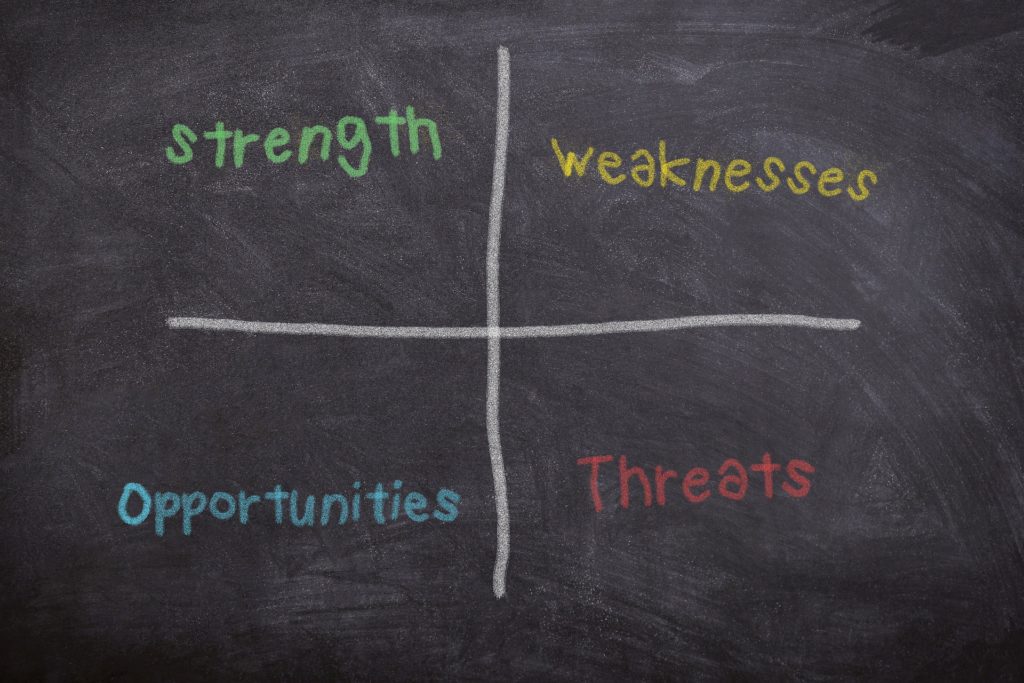
No doubt, these have been challenging times for all. The shifting landscape of the way organizations operate and how they relate with their stakeholders combined with the uncertainty of when things might again return, “to normal” creates difficulties when planning.
There is a tool that organizations of all types can utilize to help assess where they stand and how to plan a path forward. This tool is known as a “S.W.O.T. analysis”. The name “S.W.O.T.” as an acronym for the areas that an organization reviews in a focused assessment: strengths, weaknesses, opportunities and threats.
WHY COMPLETE A S.W.O.T. ANALYSIS?
S.W.O.T. analysis is an excellent organizational assessment tool. It can be used for a number of reasons. At the outset, it’s findings can be the basis for the formation of a basic business plan. For an established organization, it can help identify barriers to growth or productivity. During times of uncertainty, it can be the basis to form a firm footing to carve a new path forward. The truth is, almost any organization can benefit from a well-structured, planned and executed S.W.O.T. analysis.
Completing the assessment helps to guide needed changes in all aspects of an organization, from mission, staff recruitment and retention, stakeholder relationships and daily operations. Let us examine how the analysis progresses through each of these areas.
INTERNAL AND EXTERNAL FACTORS
There is a well-established saying in military public safety organizations that, “even the best formed plans go out the window at first contact with the enemy”. This may be true, but no one will advocate for ignoring the planning process or fail to recognize the importance of the planning process in operations. Recognize, however, that failure to consider even one critical factor of the operating environment can have devastating consequences in determining the success of an organization. Thus, considering the impact of as many of the dynamics impacting an organization during the S.W.O.T. analysis is critical. A great way to help determine these dynamics is to organize them into internal and external factors.
Internal factors are things that your organization has the ability to exert influence upon. They are impacted by the extent to which an organization engages in a particular area of focus. They include everything from establishing a corporate culture to improving how their offerings are valued by their customer base. For example, a business has positioned itself in the marketplace as the “least expensive” vendor of a particular product or service. Identifying these internal factors are the basis of identifying the strengths and weaknesses portion of the assessment. Some basic questions to ask during this part of the process:
Strengths – What is it that we do well? How are we different from others in this similar workspace?
Weaknesses – Where are we vulnerable? What challenges do we face that we might not be equipped to handle?
External factors are things that are outside of the control of the organization but significantly impact operations. Market economy, compliance issues, social and cultural trends are all examples of these factors. These will help to clarify the opportunities and threats portion of the assessment. Questions to ask during this part of the process include:
Opportunities – What has changed in the marketplace? How have public attitudes changed regarding our product or service?
Threats – What is happening that could potentially cause us problems? What are some of the things that our competitors are doing to capture market share?
The analysis can be very basic or highly complex, depending upon how much of a “deep dive” the organization wants to utilize to understand their positioning and to what degree changes are needed. The involvement of added personnel or stakeholders into the assessment will give added depth and areas to consider. For example, in one method of completing a S.W.O.T. analysis, a facilitator may “white board’ these areas with a focus group of various members representing functional areas of the organization (sales, marketing, shipping, customer service, manufacturing, repairs, etc.). The group may also involve people with various levels of authority (line worker, middle-manager, upper-management, corporate staff, executive leadership, etc.).
S.W.O.T. analysis is one of the many comprehensive tools that we use at 2X Momentum Solutions to identify best practices, specific strategies and initiatives to help you achieve your mission. Contact us today to receive a no-cost, no obligation, basic S.W.O.T. analysis of your organization.
